Child Poverty in the UK
VerifiedAdded on 2019/12/03
|26
|9292
|263
Report
AI Summary
This report investigates the significant causes and impacts of child poverty in the United Kingdom. Utilizing a descriptive research design and qualitative research techniques, the study analyzes secondary data to identify key factors contributing to child poverty, including low wages, unemployment, high expenses in low-income families, single parenthood, and teenage pregnancies. The report further examines the detrimental effects of child poverty on children's education, health, and overall community well-being. The findings highlight the urgent need for government intervention and suggest strategies such as targeted campaigns on education and health, improved social care provisions, and the development of protective policies to alleviate child poverty and its negative consequences.
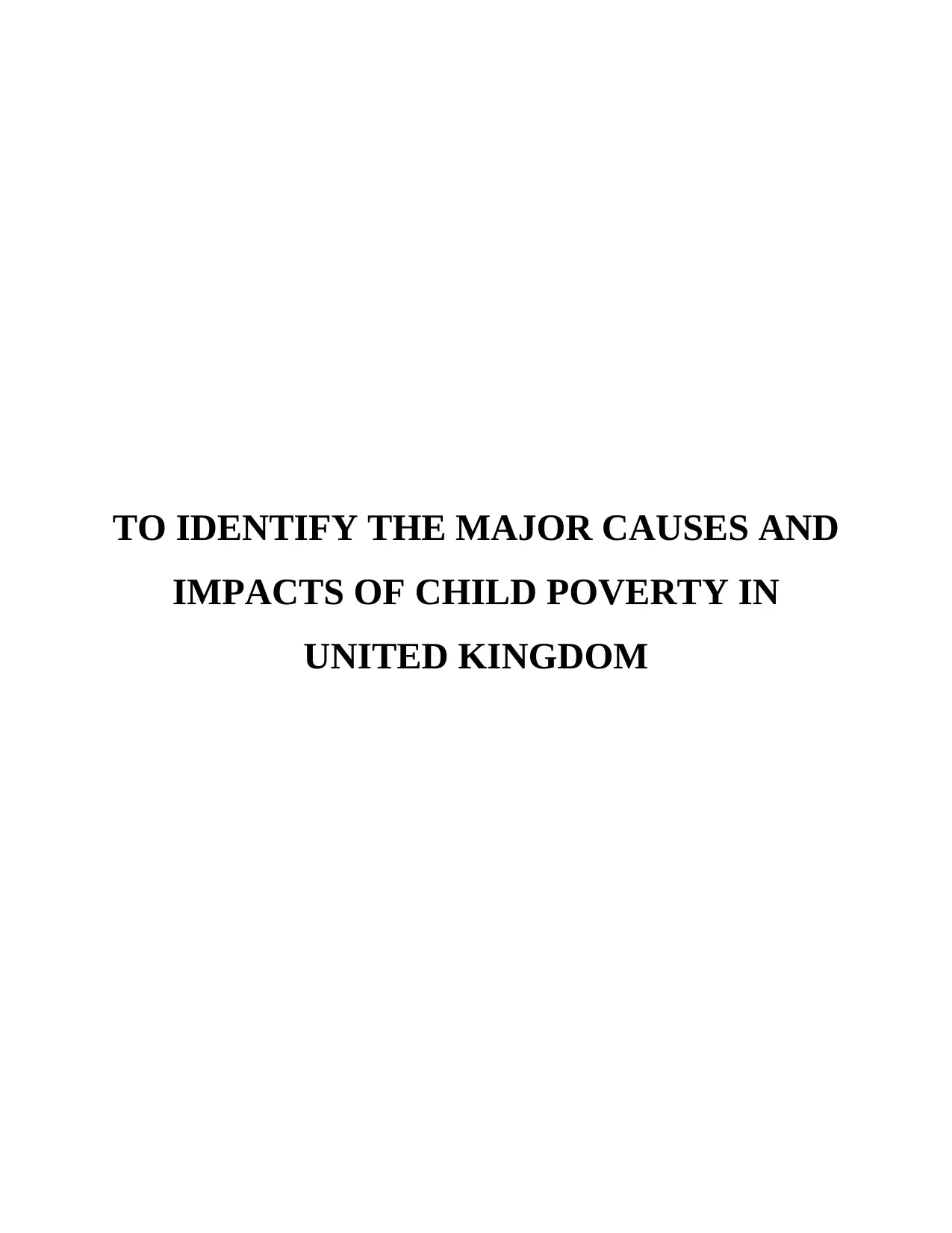
TO IDENTIFY THE MAJOR CAUSES AND
IMPACTS OF CHILD POVERTY IN
UNITED KINGDOM
IMPACTS OF CHILD POVERTY IN
UNITED KINGDOM
Paraphrase This Document
Need a fresh take? Get an instant paraphrase of this document with our AI Paraphraser
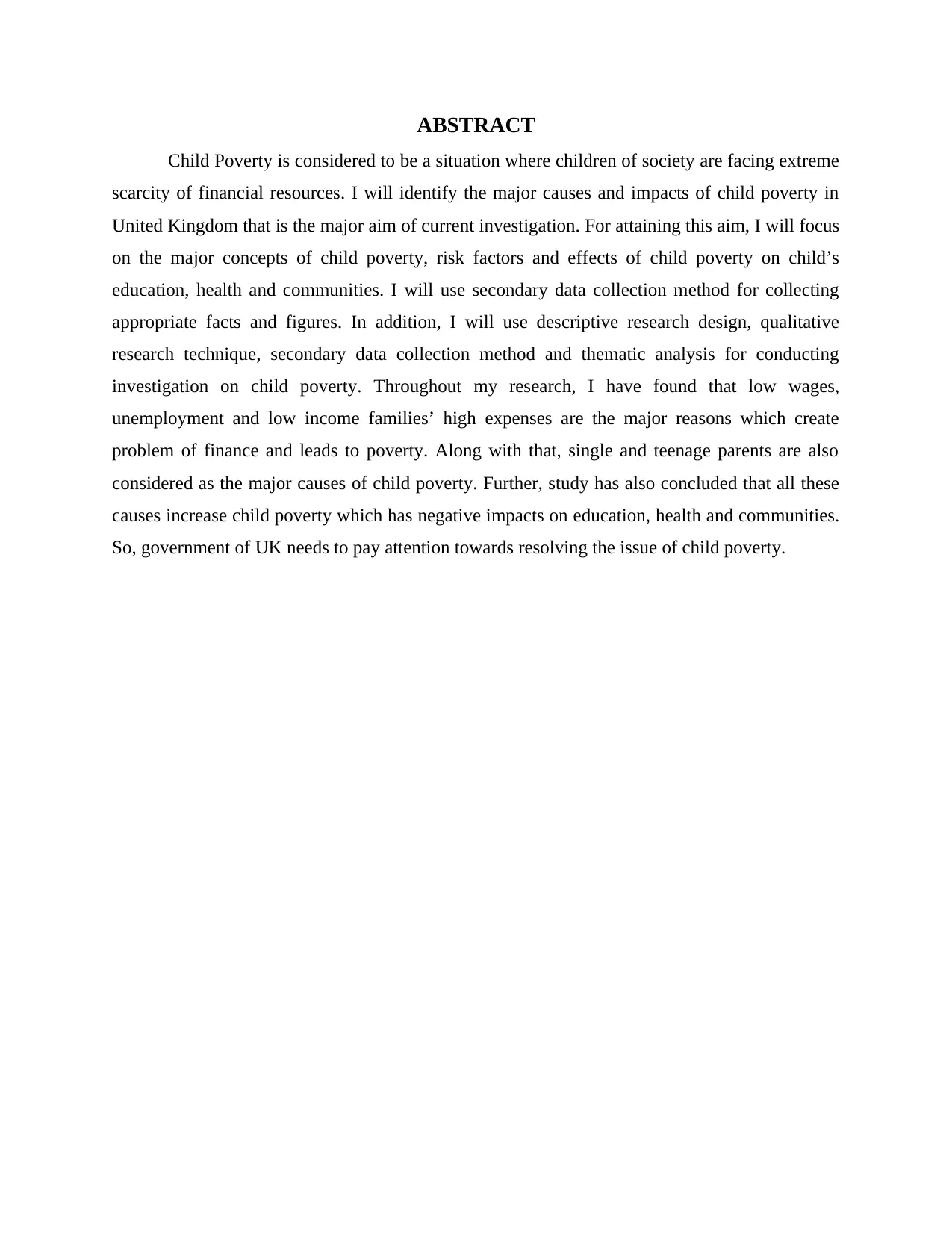
ABSTRACT
Child Poverty is considered to be a situation where children of society are facing extreme
scarcity of financial resources. I will identify the major causes and impacts of child poverty in
United Kingdom that is the major aim of current investigation. For attaining this aim, I will focus
on the major concepts of child poverty, risk factors and effects of child poverty on child’s
education, health and communities. I will use secondary data collection method for collecting
appropriate facts and figures. In addition, I will use descriptive research design, qualitative
research technique, secondary data collection method and thematic analysis for conducting
investigation on child poverty. Throughout my research, I have found that low wages,
unemployment and low income families’ high expenses are the major reasons which create
problem of finance and leads to poverty. Along with that, single and teenage parents are also
considered as the major causes of child poverty. Further, study has also concluded that all these
causes increase child poverty which has negative impacts on education, health and communities.
So, government of UK needs to pay attention towards resolving the issue of child poverty.
Child Poverty is considered to be a situation where children of society are facing extreme
scarcity of financial resources. I will identify the major causes and impacts of child poverty in
United Kingdom that is the major aim of current investigation. For attaining this aim, I will focus
on the major concepts of child poverty, risk factors and effects of child poverty on child’s
education, health and communities. I will use secondary data collection method for collecting
appropriate facts and figures. In addition, I will use descriptive research design, qualitative
research technique, secondary data collection method and thematic analysis for conducting
investigation on child poverty. Throughout my research, I have found that low wages,
unemployment and low income families’ high expenses are the major reasons which create
problem of finance and leads to poverty. Along with that, single and teenage parents are also
considered as the major causes of child poverty. Further, study has also concluded that all these
causes increase child poverty which has negative impacts on education, health and communities.
So, government of UK needs to pay attention towards resolving the issue of child poverty.
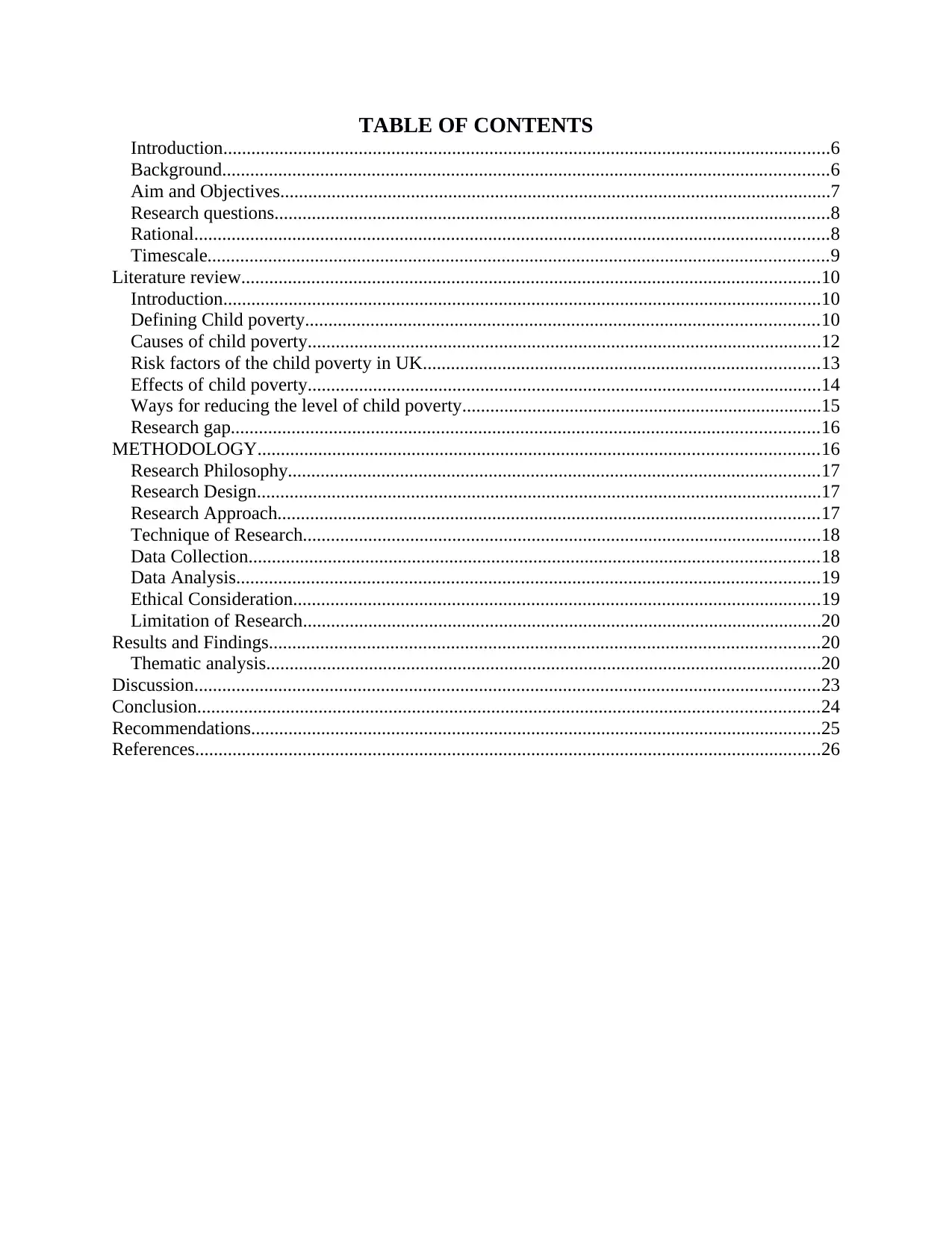
TABLE OF CONTENTS
Introduction..................................................................................................................................6
Background..................................................................................................................................6
Aim and Objectives......................................................................................................................7
Research questions.......................................................................................................................8
Rational........................................................................................................................................8
Timescale.....................................................................................................................................9
Literature review............................................................................................................................10
Introduction................................................................................................................................10
Defining Child poverty..............................................................................................................10
Causes of child poverty..............................................................................................................12
Risk factors of the child poverty in UK.....................................................................................13
Effects of child poverty..............................................................................................................14
Ways for reducing the level of child poverty.............................................................................15
Research gap..............................................................................................................................16
METHODOLOGY........................................................................................................................16
Research Philosophy..................................................................................................................17
Research Design.........................................................................................................................17
Research Approach....................................................................................................................17
Technique of Research...............................................................................................................18
Data Collection..........................................................................................................................18
Data Analysis.............................................................................................................................19
Ethical Consideration.................................................................................................................19
Limitation of Research...............................................................................................................20
Results and Findings......................................................................................................................20
Thematic analysis.......................................................................................................................20
Discussion......................................................................................................................................23
Conclusion.....................................................................................................................................24
Recommendations..........................................................................................................................25
References......................................................................................................................................26
Introduction..................................................................................................................................6
Background..................................................................................................................................6
Aim and Objectives......................................................................................................................7
Research questions.......................................................................................................................8
Rational........................................................................................................................................8
Timescale.....................................................................................................................................9
Literature review............................................................................................................................10
Introduction................................................................................................................................10
Defining Child poverty..............................................................................................................10
Causes of child poverty..............................................................................................................12
Risk factors of the child poverty in UK.....................................................................................13
Effects of child poverty..............................................................................................................14
Ways for reducing the level of child poverty.............................................................................15
Research gap..............................................................................................................................16
METHODOLOGY........................................................................................................................16
Research Philosophy..................................................................................................................17
Research Design.........................................................................................................................17
Research Approach....................................................................................................................17
Technique of Research...............................................................................................................18
Data Collection..........................................................................................................................18
Data Analysis.............................................................................................................................19
Ethical Consideration.................................................................................................................19
Limitation of Research...............................................................................................................20
Results and Findings......................................................................................................................20
Thematic analysis.......................................................................................................................20
Discussion......................................................................................................................................23
Conclusion.....................................................................................................................................24
Recommendations..........................................................................................................................25
References......................................................................................................................................26
⊘ This is a preview!⊘
Do you want full access?
Subscribe today to unlock all pages.

Trusted by 1+ million students worldwide
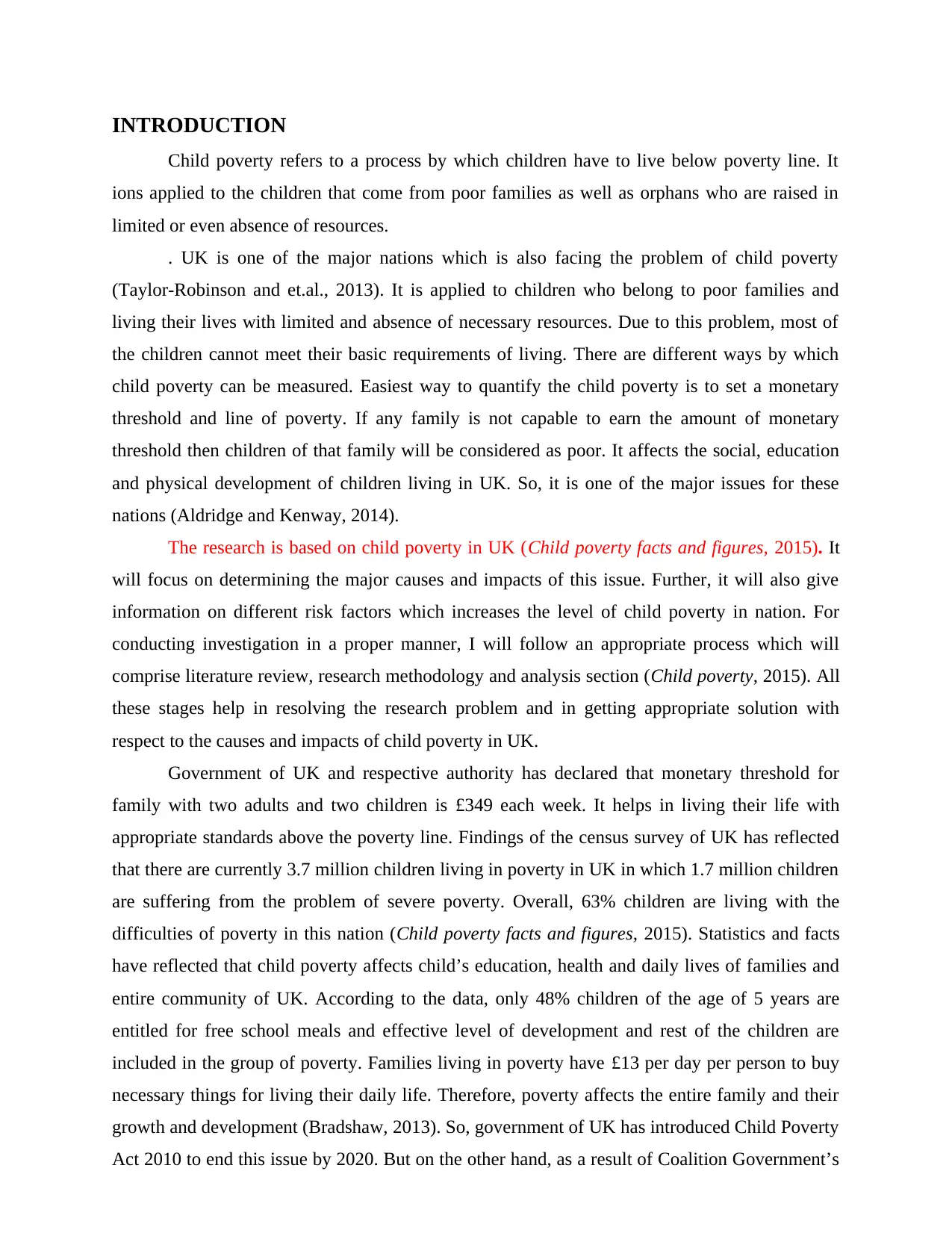
INTRODUCTION
Child poverty refers to a process by which children have to live below poverty line. It
ions applied to the children that come from poor families as well as orphans who are raised in
limited or even absence of resources.
. UK is one of the major nations which is also facing the problem of child poverty
(Taylor-Robinson and et.al., 2013). It is applied to children who belong to poor families and
living their lives with limited and absence of necessary resources. Due to this problem, most of
the children cannot meet their basic requirements of living. There are different ways by which
child poverty can be measured. Easiest way to quantify the child poverty is to set a monetary
threshold and line of poverty. If any family is not capable to earn the amount of monetary
threshold then children of that family will be considered as poor. It affects the social, education
and physical development of children living in UK. So, it is one of the major issues for these
nations (Aldridge and Kenway, 2014).
The research is based on child poverty in UK (Child poverty facts and figures, 2015). It
will focus on determining the major causes and impacts of this issue. Further, it will also give
information on different risk factors which increases the level of child poverty in nation. For
conducting investigation in a proper manner, I will follow an appropriate process which will
comprise literature review, research methodology and analysis section (Child poverty, 2015). All
these stages help in resolving the research problem and in getting appropriate solution with
respect to the causes and impacts of child poverty in UK.
Government of UK and respective authority has declared that monetary threshold for
family with two adults and two children is £349 each week. It helps in living their life with
appropriate standards above the poverty line. Findings of the census survey of UK has reflected
that there are currently 3.7 million children living in poverty in UK in which 1.7 million children
are suffering from the problem of severe poverty. Overall, 63% children are living with the
difficulties of poverty in this nation (Child poverty facts and figures, 2015). Statistics and facts
have reflected that child poverty affects child’s education, health and daily lives of families and
entire community of UK. According to the data, only 48% children of the age of 5 years are
entitled for free school meals and effective level of development and rest of the children are
included in the group of poverty. Families living in poverty have £13 per day per person to buy
necessary things for living their daily life. Therefore, poverty affects the entire family and their
growth and development (Bradshaw, 2013). So, government of UK has introduced Child Poverty
Act 2010 to end this issue by 2020. But on the other hand, as a result of Coalition Government’s
Child poverty refers to a process by which children have to live below poverty line. It
ions applied to the children that come from poor families as well as orphans who are raised in
limited or even absence of resources.
. UK is one of the major nations which is also facing the problem of child poverty
(Taylor-Robinson and et.al., 2013). It is applied to children who belong to poor families and
living their lives with limited and absence of necessary resources. Due to this problem, most of
the children cannot meet their basic requirements of living. There are different ways by which
child poverty can be measured. Easiest way to quantify the child poverty is to set a monetary
threshold and line of poverty. If any family is not capable to earn the amount of monetary
threshold then children of that family will be considered as poor. It affects the social, education
and physical development of children living in UK. So, it is one of the major issues for these
nations (Aldridge and Kenway, 2014).
The research is based on child poverty in UK (Child poverty facts and figures, 2015). It
will focus on determining the major causes and impacts of this issue. Further, it will also give
information on different risk factors which increases the level of child poverty in nation. For
conducting investigation in a proper manner, I will follow an appropriate process which will
comprise literature review, research methodology and analysis section (Child poverty, 2015). All
these stages help in resolving the research problem and in getting appropriate solution with
respect to the causes and impacts of child poverty in UK.
Government of UK and respective authority has declared that monetary threshold for
family with two adults and two children is £349 each week. It helps in living their life with
appropriate standards above the poverty line. Findings of the census survey of UK has reflected
that there are currently 3.7 million children living in poverty in UK in which 1.7 million children
are suffering from the problem of severe poverty. Overall, 63% children are living with the
difficulties of poverty in this nation (Child poverty facts and figures, 2015). Statistics and facts
have reflected that child poverty affects child’s education, health and daily lives of families and
entire community of UK. According to the data, only 48% children of the age of 5 years are
entitled for free school meals and effective level of development and rest of the children are
included in the group of poverty. Families living in poverty have £13 per day per person to buy
necessary things for living their daily life. Therefore, poverty affects the entire family and their
growth and development (Bradshaw, 2013). So, government of UK has introduced Child Poverty
Act 2010 to end this issue by 2020. But on the other hand, as a result of Coalition Government’s
Paraphrase This Document
Need a fresh take? Get an instant paraphrase of this document with our AI Paraphraser
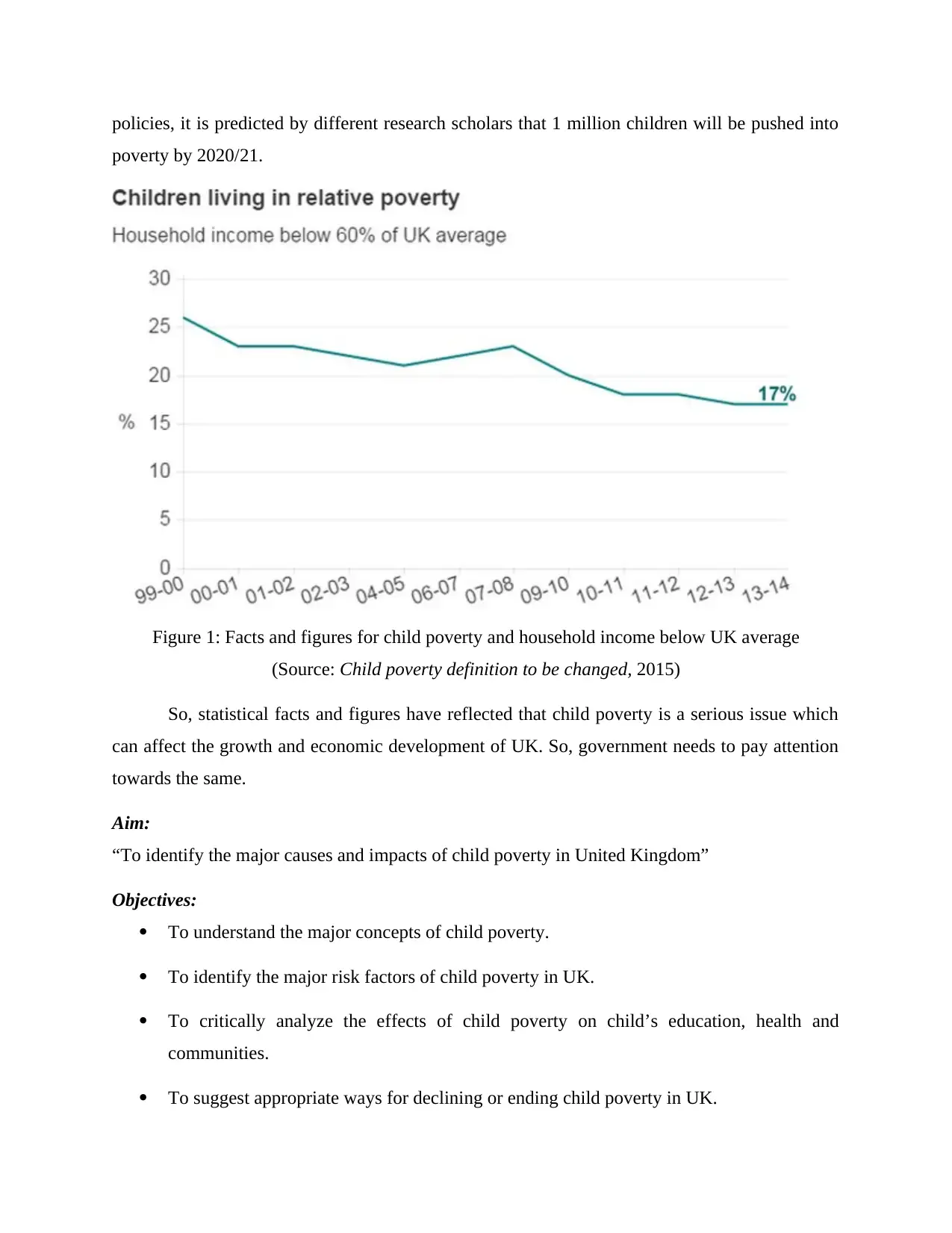
policies, it is predicted by different research scholars that 1 million children will be pushed into
poverty by 2020/21.
Figure 1: Facts and figures for child poverty and household income below UK average
(Source: Child poverty definition to be changed, 2015)
So, statistical facts and figures have reflected that child poverty is a serious issue which
can affect the growth and economic development of UK. So, government needs to pay attention
towards the same.
Aim:
“To identify the major causes and impacts of child poverty in United Kingdom”
Objectives:
To understand the major concepts of child poverty.
To identify the major risk factors of child poverty in UK.
To critically analyze the effects of child poverty on child’s education, health and
communities.
To suggest appropriate ways for declining or ending child poverty in UK.
poverty by 2020/21.
Figure 1: Facts and figures for child poverty and household income below UK average
(Source: Child poverty definition to be changed, 2015)
So, statistical facts and figures have reflected that child poverty is a serious issue which
can affect the growth and economic development of UK. So, government needs to pay attention
towards the same.
Aim:
“To identify the major causes and impacts of child poverty in United Kingdom”
Objectives:
To understand the major concepts of child poverty.
To identify the major risk factors of child poverty in UK.
To critically analyze the effects of child poverty on child’s education, health and
communities.
To suggest appropriate ways for declining or ending child poverty in UK.
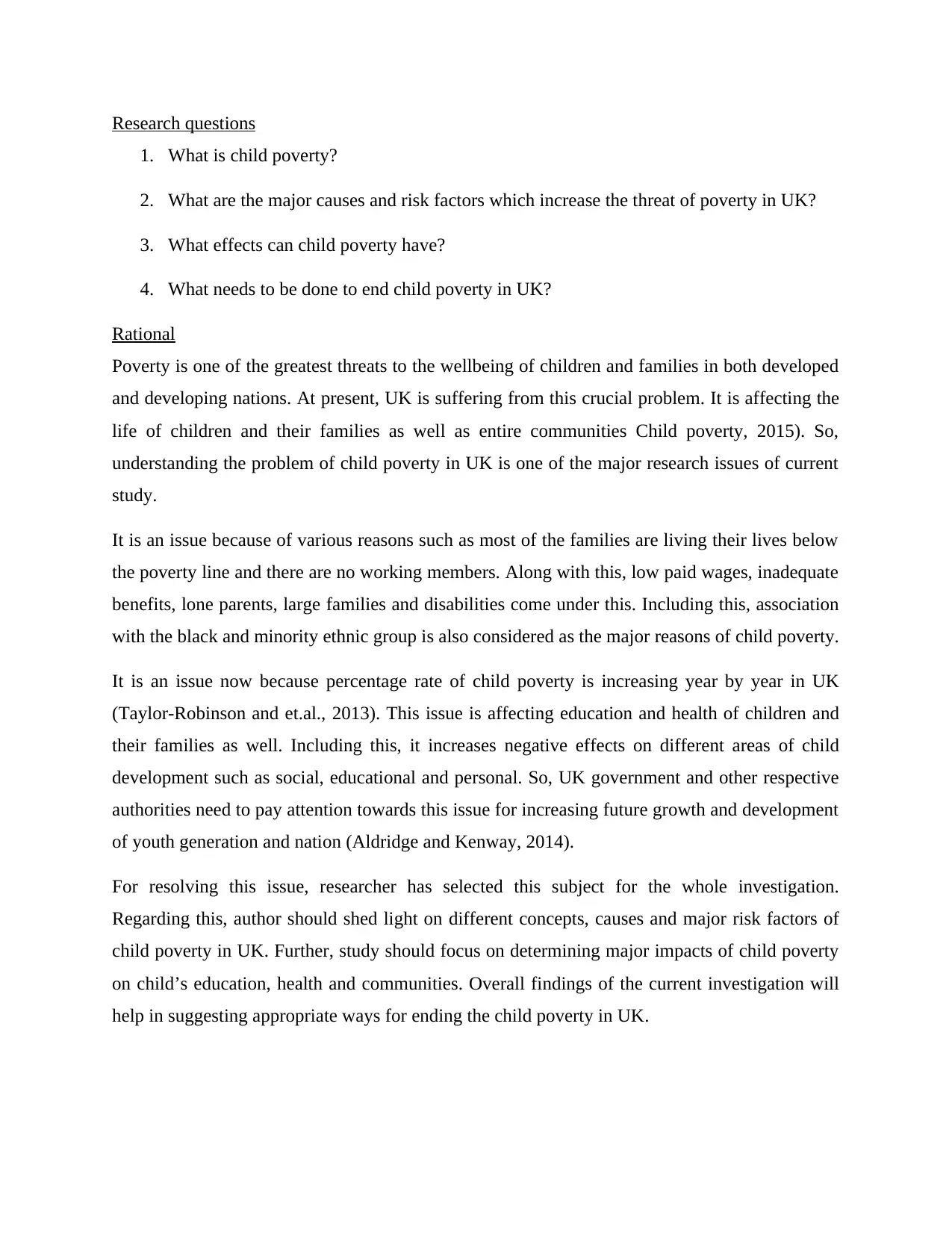
Research questions
1. What is child poverty?
2. What are the major causes and risk factors which increase the threat of poverty in UK?
3. What effects can child poverty have?
4. What needs to be done to end child poverty in UK?
Rational
Poverty is one of the greatest threats to the wellbeing of children and families in both developed
and developing nations. At present, UK is suffering from this crucial problem. It is affecting the
life of children and their families as well as entire communities Child poverty, 2015). So,
understanding the problem of child poverty in UK is one of the major research issues of current
study.
It is an issue because of various reasons such as most of the families are living their lives below
the poverty line and there are no working members. Along with this, low paid wages, inadequate
benefits, lone parents, large families and disabilities come under this. Including this, association
with the black and minority ethnic group is also considered as the major reasons of child poverty.
It is an issue now because percentage rate of child poverty is increasing year by year in UK
(Taylor-Robinson and et.al., 2013). This issue is affecting education and health of children and
their families as well. Including this, it increases negative effects on different areas of child
development such as social, educational and personal. So, UK government and other respective
authorities need to pay attention towards this issue for increasing future growth and development
of youth generation and nation (Aldridge and Kenway, 2014).
For resolving this issue, researcher has selected this subject for the whole investigation.
Regarding this, author should shed light on different concepts, causes and major risk factors of
child poverty in UK. Further, study should focus on determining major impacts of child poverty
on child’s education, health and communities. Overall findings of the current investigation will
help in suggesting appropriate ways for ending the child poverty in UK.
1. What is child poverty?
2. What are the major causes and risk factors which increase the threat of poverty in UK?
3. What effects can child poverty have?
4. What needs to be done to end child poverty in UK?
Rational
Poverty is one of the greatest threats to the wellbeing of children and families in both developed
and developing nations. At present, UK is suffering from this crucial problem. It is affecting the
life of children and their families as well as entire communities Child poverty, 2015). So,
understanding the problem of child poverty in UK is one of the major research issues of current
study.
It is an issue because of various reasons such as most of the families are living their lives below
the poverty line and there are no working members. Along with this, low paid wages, inadequate
benefits, lone parents, large families and disabilities come under this. Including this, association
with the black and minority ethnic group is also considered as the major reasons of child poverty.
It is an issue now because percentage rate of child poverty is increasing year by year in UK
(Taylor-Robinson and et.al., 2013). This issue is affecting education and health of children and
their families as well. Including this, it increases negative effects on different areas of child
development such as social, educational and personal. So, UK government and other respective
authorities need to pay attention towards this issue for increasing future growth and development
of youth generation and nation (Aldridge and Kenway, 2014).
For resolving this issue, researcher has selected this subject for the whole investigation.
Regarding this, author should shed light on different concepts, causes and major risk factors of
child poverty in UK. Further, study should focus on determining major impacts of child poverty
on child’s education, health and communities. Overall findings of the current investigation will
help in suggesting appropriate ways for ending the child poverty in UK.
⊘ This is a preview!⊘
Do you want full access?
Subscribe today to unlock all pages.

Trusted by 1+ million students worldwide
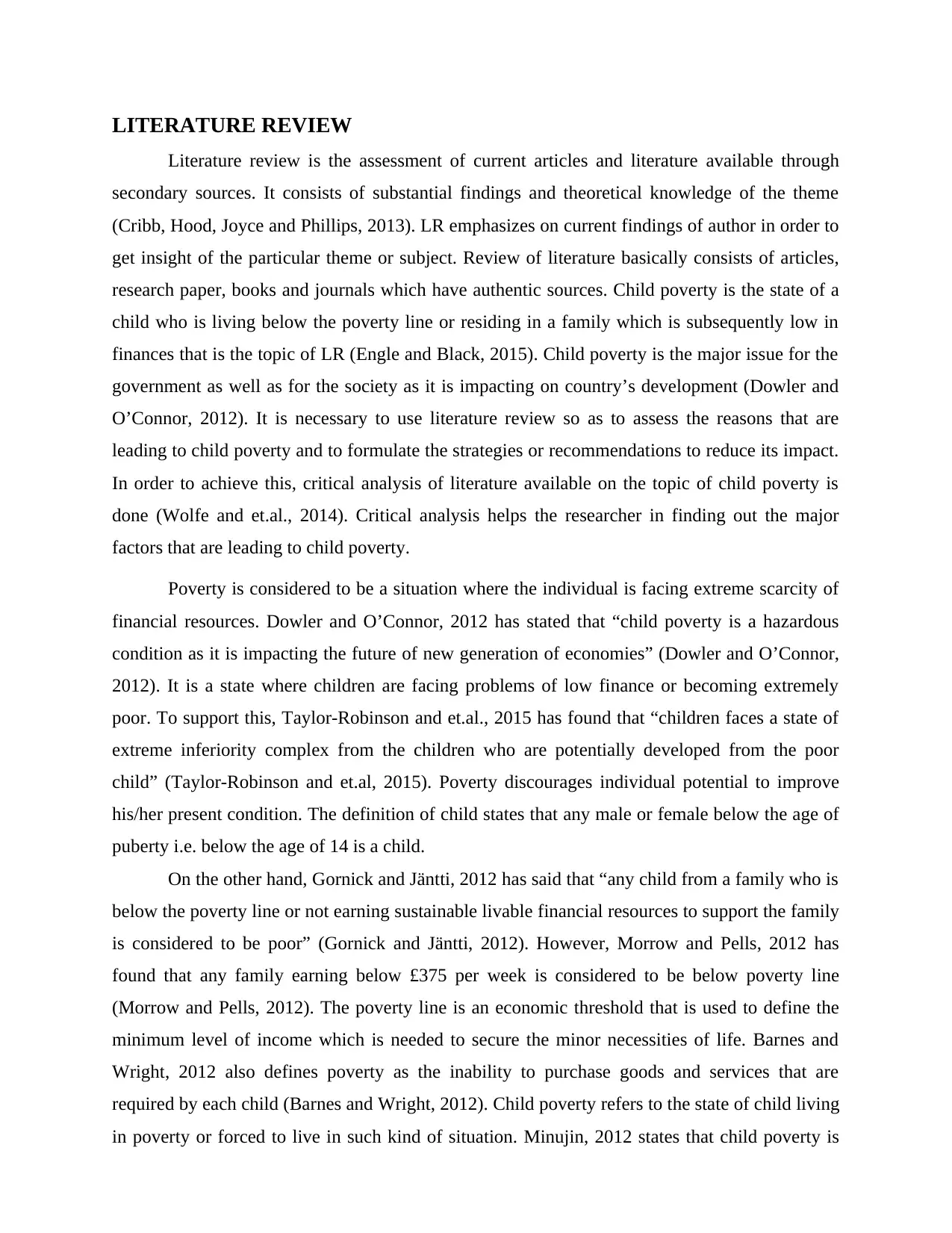
LITERATURE REVIEW
Literature review is the assessment of current articles and literature available through
secondary sources. It consists of substantial findings and theoretical knowledge of the theme
(Cribb, Hood, Joyce and Phillips, 2013). LR emphasizes on current findings of author in order to
get insight of the particular theme or subject. Review of literature basically consists of articles,
research paper, books and journals which have authentic sources. Child poverty is the state of a
child who is living below the poverty line or residing in a family which is subsequently low in
finances that is the topic of LR (Engle and Black, 2015). Child poverty is the major issue for the
government as well as for the society as it is impacting on country’s development (Dowler and
O’Connor, 2012). It is necessary to use literature review so as to assess the reasons that are
leading to child poverty and to formulate the strategies or recommendations to reduce its impact.
In order to achieve this, critical analysis of literature available on the topic of child poverty is
done (Wolfe and et.al., 2014). Critical analysis helps the researcher in finding out the major
factors that are leading to child poverty.
Poverty is considered to be a situation where the individual is facing extreme scarcity of
financial resources. Dowler and O’Connor, 2012 has stated that “child poverty is a hazardous
condition as it is impacting the future of new generation of economies” (Dowler and O’Connor,
2012). It is a state where children are facing problems of low finance or becoming extremely
poor. To support this, Taylor-Robinson and et.al., 2015 has found that “children faces a state of
extreme inferiority complex from the children who are potentially developed from the poor
child” (Taylor-Robinson and et.al, 2015). Poverty discourages individual potential to improve
his/her present condition. The definition of child states that any male or female below the age of
puberty i.e. below the age of 14 is a child.
On the other hand, Gornick and Jäntti, 2012 has said that “any child from a family who is
below the poverty line or not earning sustainable livable financial resources to support the family
is considered to be poor” (Gornick and Jäntti, 2012). However, Morrow and Pells, 2012 has
found that any family earning below £375 per week is considered to be below poverty line
(Morrow and Pells, 2012). The poverty line is an economic threshold that is used to define the
minimum level of income which is needed to secure the minor necessities of life. Barnes and
Wright, 2012 also defines poverty as the inability to purchase goods and services that are
required by each child (Barnes and Wright, 2012). Child poverty refers to the state of child living
in poverty or forced to live in such kind of situation. Minujin, 2012 states that child poverty is
Literature review is the assessment of current articles and literature available through
secondary sources. It consists of substantial findings and theoretical knowledge of the theme
(Cribb, Hood, Joyce and Phillips, 2013). LR emphasizes on current findings of author in order to
get insight of the particular theme or subject. Review of literature basically consists of articles,
research paper, books and journals which have authentic sources. Child poverty is the state of a
child who is living below the poverty line or residing in a family which is subsequently low in
finances that is the topic of LR (Engle and Black, 2015). Child poverty is the major issue for the
government as well as for the society as it is impacting on country’s development (Dowler and
O’Connor, 2012). It is necessary to use literature review so as to assess the reasons that are
leading to child poverty and to formulate the strategies or recommendations to reduce its impact.
In order to achieve this, critical analysis of literature available on the topic of child poverty is
done (Wolfe and et.al., 2014). Critical analysis helps the researcher in finding out the major
factors that are leading to child poverty.
Poverty is considered to be a situation where the individual is facing extreme scarcity of
financial resources. Dowler and O’Connor, 2012 has stated that “child poverty is a hazardous
condition as it is impacting the future of new generation of economies” (Dowler and O’Connor,
2012). It is a state where children are facing problems of low finance or becoming extremely
poor. To support this, Taylor-Robinson and et.al., 2015 has found that “children faces a state of
extreme inferiority complex from the children who are potentially developed from the poor
child” (Taylor-Robinson and et.al, 2015). Poverty discourages individual potential to improve
his/her present condition. The definition of child states that any male or female below the age of
puberty i.e. below the age of 14 is a child.
On the other hand, Gornick and Jäntti, 2012 has said that “any child from a family who is
below the poverty line or not earning sustainable livable financial resources to support the family
is considered to be poor” (Gornick and Jäntti, 2012). However, Morrow and Pells, 2012 has
found that any family earning below £375 per week is considered to be below poverty line
(Morrow and Pells, 2012). The poverty line is an economic threshold that is used to define the
minimum level of income which is needed to secure the minor necessities of life. Barnes and
Wright, 2012 also defines poverty as the inability to purchase goods and services that are
required by each child (Barnes and Wright, 2012). Child poverty refers to the state of child living
in poverty or forced to live in such kind of situation. Minujin, 2012 states that child poverty is
Paraphrase This Document
Need a fresh take? Get an instant paraphrase of this document with our AI Paraphraser
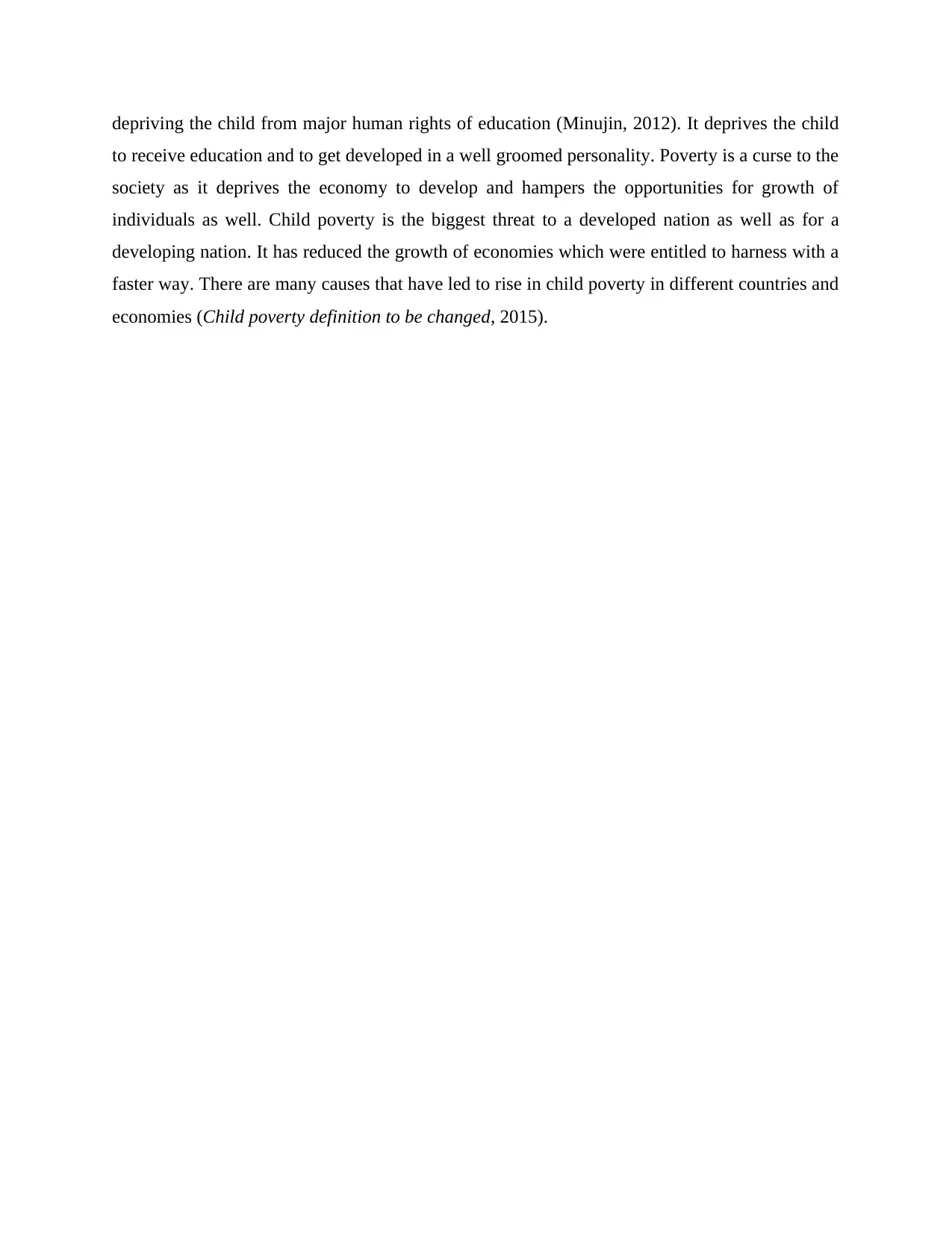
depriving the child from major human rights of education (Minujin, 2012). It deprives the child
to receive education and to get developed in a well groomed personality. Poverty is a curse to the
society as it deprives the economy to develop and hampers the opportunities for growth of
individuals as well. Child poverty is the biggest threat to a developed nation as well as for a
developing nation. It has reduced the growth of economies which were entitled to harness with a
faster way. There are many causes that have led to rise in child poverty in different countries and
economies (Child poverty definition to be changed, 2015).
to receive education and to get developed in a well groomed personality. Poverty is a curse to the
society as it deprives the economy to develop and hampers the opportunities for growth of
individuals as well. Child poverty is the biggest threat to a developed nation as well as for a
developing nation. It has reduced the growth of economies which were entitled to harness with a
faster way. There are many causes that have led to rise in child poverty in different countries and
economies (Child poverty definition to be changed, 2015).
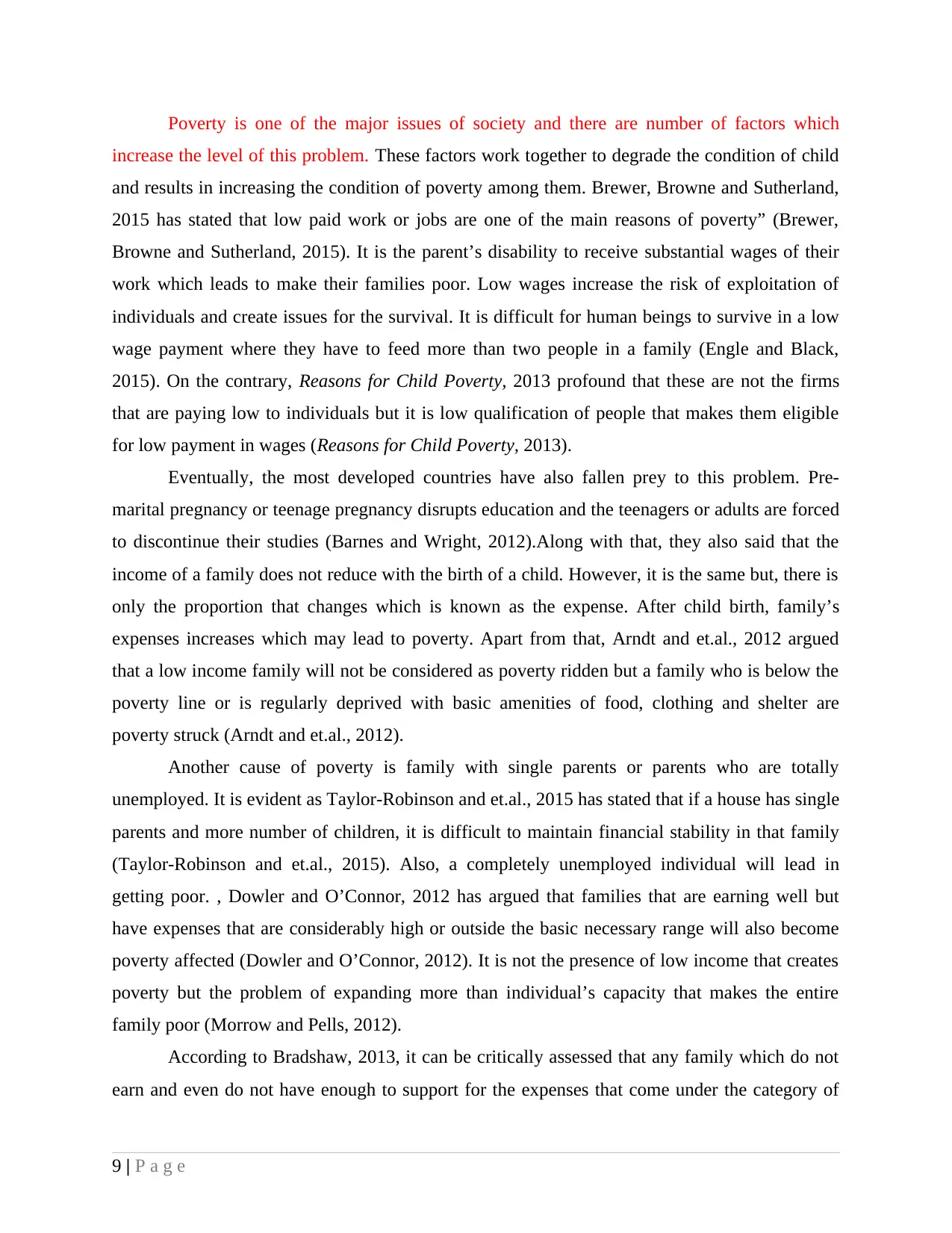
Poverty is one of the major issues of society and there are number of factors which
increase the level of this problem. These factors work together to degrade the condition of child
and results in increasing the condition of poverty among them. Brewer, Browne and Sutherland,
2015 has stated that low paid work or jobs are one of the main reasons of poverty” (Brewer,
Browne and Sutherland, 2015). It is the parent’s disability to receive substantial wages of their
work which leads to make their families poor. Low wages increase the risk of exploitation of
individuals and create issues for the survival. It is difficult for human beings to survive in a low
wage payment where they have to feed more than two people in a family (Engle and Black,
2015). On the contrary, Reasons for Child Poverty, 2013 profound that these are not the firms
that are paying low to individuals but it is low qualification of people that makes them eligible
for low payment in wages (Reasons for Child Poverty, 2013).
Eventually, the most developed countries have also fallen prey to this problem. Pre-
marital pregnancy or teenage pregnancy disrupts education and the teenagers or adults are forced
to discontinue their studies (Barnes and Wright, 2012).Along with that, they also said that the
income of a family does not reduce with the birth of a child. However, it is the same but, there is
only the proportion that changes which is known as the expense. After child birth, family’s
expenses increases which may lead to poverty. Apart from that, Arndt and et.al., 2012 argued
that a low income family will not be considered as poverty ridden but a family who is below the
poverty line or is regularly deprived with basic amenities of food, clothing and shelter are
poverty struck (Arndt and et.al., 2012).
Another cause of poverty is family with single parents or parents who are totally
unemployed. It is evident as Taylor-Robinson and et.al., 2015 has stated that if a house has single
parents and more number of children, it is difficult to maintain financial stability in that family
(Taylor-Robinson and et.al., 2015). Also, a completely unemployed individual will lead in
getting poor. , Dowler and O’Connor, 2012 has argued that families that are earning well but
have expenses that are considerably high or outside the basic necessary range will also become
poverty affected (Dowler and O’Connor, 2012). It is not the presence of low income that creates
poverty but the problem of expanding more than individual’s capacity that makes the entire
family poor (Morrow and Pells, 2012).
According to Bradshaw, 2013, it can be critically assessed that any family which do not
earn and even do not have enough to support for the expenses that come under the category of
9 | P a g e
increase the level of this problem. These factors work together to degrade the condition of child
and results in increasing the condition of poverty among them. Brewer, Browne and Sutherland,
2015 has stated that low paid work or jobs are one of the main reasons of poverty” (Brewer,
Browne and Sutherland, 2015). It is the parent’s disability to receive substantial wages of their
work which leads to make their families poor. Low wages increase the risk of exploitation of
individuals and create issues for the survival. It is difficult for human beings to survive in a low
wage payment where they have to feed more than two people in a family (Engle and Black,
2015). On the contrary, Reasons for Child Poverty, 2013 profound that these are not the firms
that are paying low to individuals but it is low qualification of people that makes them eligible
for low payment in wages (Reasons for Child Poverty, 2013).
Eventually, the most developed countries have also fallen prey to this problem. Pre-
marital pregnancy or teenage pregnancy disrupts education and the teenagers or adults are forced
to discontinue their studies (Barnes and Wright, 2012).Along with that, they also said that the
income of a family does not reduce with the birth of a child. However, it is the same but, there is
only the proportion that changes which is known as the expense. After child birth, family’s
expenses increases which may lead to poverty. Apart from that, Arndt and et.al., 2012 argued
that a low income family will not be considered as poverty ridden but a family who is below the
poverty line or is regularly deprived with basic amenities of food, clothing and shelter are
poverty struck (Arndt and et.al., 2012).
Another cause of poverty is family with single parents or parents who are totally
unemployed. It is evident as Taylor-Robinson and et.al., 2015 has stated that if a house has single
parents and more number of children, it is difficult to maintain financial stability in that family
(Taylor-Robinson and et.al., 2015). Also, a completely unemployed individual will lead in
getting poor. , Dowler and O’Connor, 2012 has argued that families that are earning well but
have expenses that are considerably high or outside the basic necessary range will also become
poverty affected (Dowler and O’Connor, 2012). It is not the presence of low income that creates
poverty but the problem of expanding more than individual’s capacity that makes the entire
family poor (Morrow and Pells, 2012).
According to Bradshaw, 2013, it can be critically assessed that any family which do not
earn and even do not have enough to support for the expenses that come under the category of
9 | P a g e
⊘ This is a preview!⊘
Do you want full access?
Subscribe today to unlock all pages.

Trusted by 1+ million students worldwide
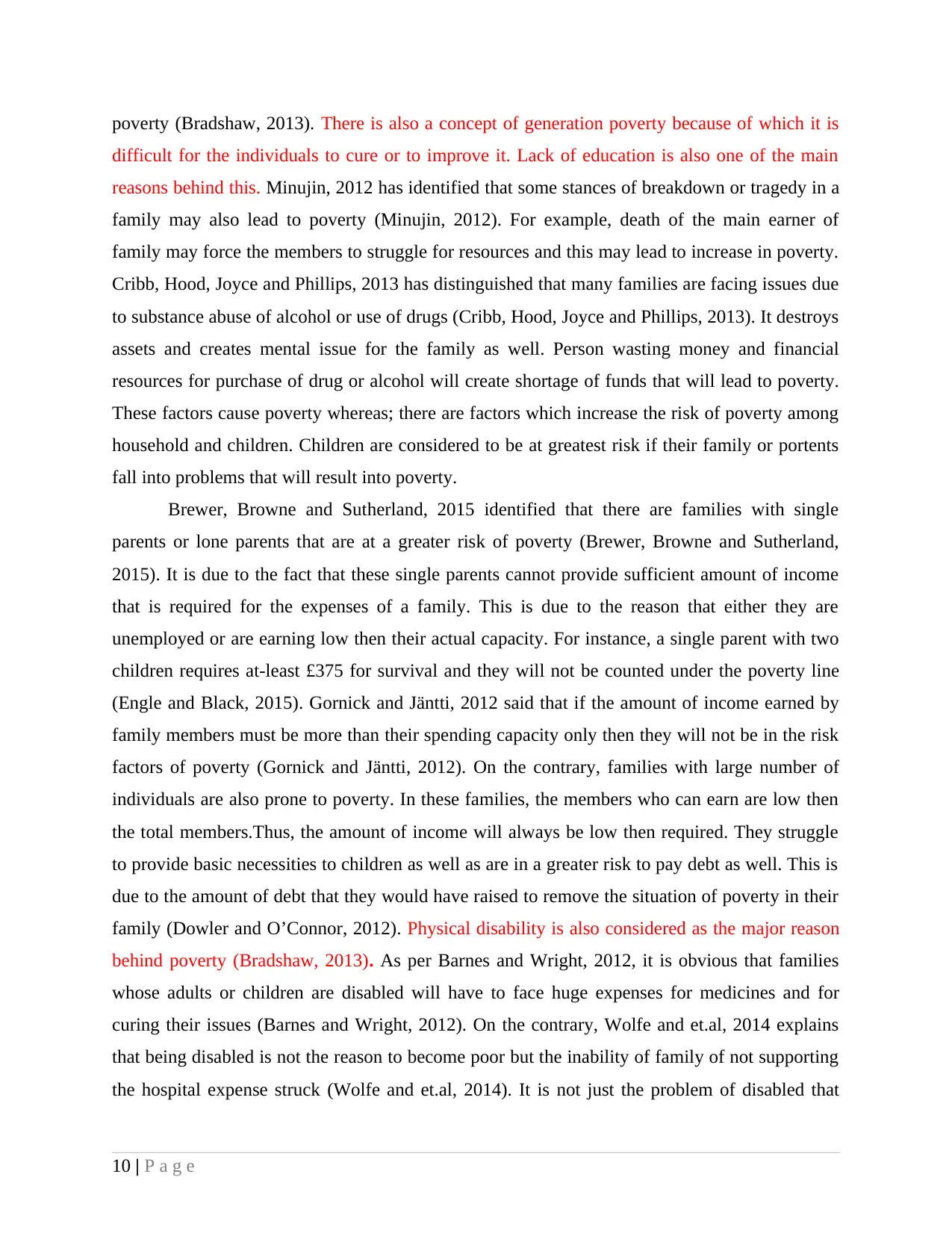
poverty (Bradshaw, 2013). There is also a concept of generation poverty because of which it is
difficult for the individuals to cure or to improve it. Lack of education is also one of the main
reasons behind this. Minujin, 2012 has identified that some stances of breakdown or tragedy in a
family may also lead to poverty (Minujin, 2012). For example, death of the main earner of
family may force the members to struggle for resources and this may lead to increase in poverty.
Cribb, Hood, Joyce and Phillips, 2013 has distinguished that many families are facing issues due
to substance abuse of alcohol or use of drugs (Cribb, Hood, Joyce and Phillips, 2013). It destroys
assets and creates mental issue for the family as well. Person wasting money and financial
resources for purchase of drug or alcohol will create shortage of funds that will lead to poverty.
These factors cause poverty whereas; there are factors which increase the risk of poverty among
household and children. Children are considered to be at greatest risk if their family or portents
fall into problems that will result into poverty.
Brewer, Browne and Sutherland, 2015 identified that there are families with single
parents or lone parents that are at a greater risk of poverty (Brewer, Browne and Sutherland,
2015). It is due to the fact that these single parents cannot provide sufficient amount of income
that is required for the expenses of a family. This is due to the reason that either they are
unemployed or are earning low then their actual capacity. For instance, a single parent with two
children requires at-least £375 for survival and they will not be counted under the poverty line
(Engle and Black, 2015). Gornick and Jäntti, 2012 said that if the amount of income earned by
family members must be more than their spending capacity only then they will not be in the risk
factors of poverty (Gornick and Jäntti, 2012). On the contrary, families with large number of
individuals are also prone to poverty. In these families, the members who can earn are low then
the total members.Thus, the amount of income will always be low then required. They struggle
to provide basic necessities to children as well as are in a greater risk to pay debt as well. This is
due to the amount of debt that they would have raised to remove the situation of poverty in their
family (Dowler and O’Connor, 2012). Physical disability is also considered as the major reason
behind poverty (Bradshaw, 2013). As per Barnes and Wright, 2012, it is obvious that families
whose adults or children are disabled will have to face huge expenses for medicines and for
curing their issues (Barnes and Wright, 2012). On the contrary, Wolfe and et.al, 2014 explains
that being disabled is not the reason to become poor but the inability of family of not supporting
the hospital expense struck (Wolfe and et.al, 2014). It is not just the problem of disabled that
10 | P a g e
difficult for the individuals to cure or to improve it. Lack of education is also one of the main
reasons behind this. Minujin, 2012 has identified that some stances of breakdown or tragedy in a
family may also lead to poverty (Minujin, 2012). For example, death of the main earner of
family may force the members to struggle for resources and this may lead to increase in poverty.
Cribb, Hood, Joyce and Phillips, 2013 has distinguished that many families are facing issues due
to substance abuse of alcohol or use of drugs (Cribb, Hood, Joyce and Phillips, 2013). It destroys
assets and creates mental issue for the family as well. Person wasting money and financial
resources for purchase of drug or alcohol will create shortage of funds that will lead to poverty.
These factors cause poverty whereas; there are factors which increase the risk of poverty among
household and children. Children are considered to be at greatest risk if their family or portents
fall into problems that will result into poverty.
Brewer, Browne and Sutherland, 2015 identified that there are families with single
parents or lone parents that are at a greater risk of poverty (Brewer, Browne and Sutherland,
2015). It is due to the fact that these single parents cannot provide sufficient amount of income
that is required for the expenses of a family. This is due to the reason that either they are
unemployed or are earning low then their actual capacity. For instance, a single parent with two
children requires at-least £375 for survival and they will not be counted under the poverty line
(Engle and Black, 2015). Gornick and Jäntti, 2012 said that if the amount of income earned by
family members must be more than their spending capacity only then they will not be in the risk
factors of poverty (Gornick and Jäntti, 2012). On the contrary, families with large number of
individuals are also prone to poverty. In these families, the members who can earn are low then
the total members.Thus, the amount of income will always be low then required. They struggle
to provide basic necessities to children as well as are in a greater risk to pay debt as well. This is
due to the amount of debt that they would have raised to remove the situation of poverty in their
family (Dowler and O’Connor, 2012). Physical disability is also considered as the major reason
behind poverty (Bradshaw, 2013). As per Barnes and Wright, 2012, it is obvious that families
whose adults or children are disabled will have to face huge expenses for medicines and for
curing their issues (Barnes and Wright, 2012). On the contrary, Wolfe and et.al, 2014 explains
that being disabled is not the reason to become poor but the inability of family of not supporting
the hospital expense struck (Wolfe and et.al, 2014). It is not just the problem of disabled that
10 | P a g e
Paraphrase This Document
Need a fresh take? Get an instant paraphrase of this document with our AI Paraphraser
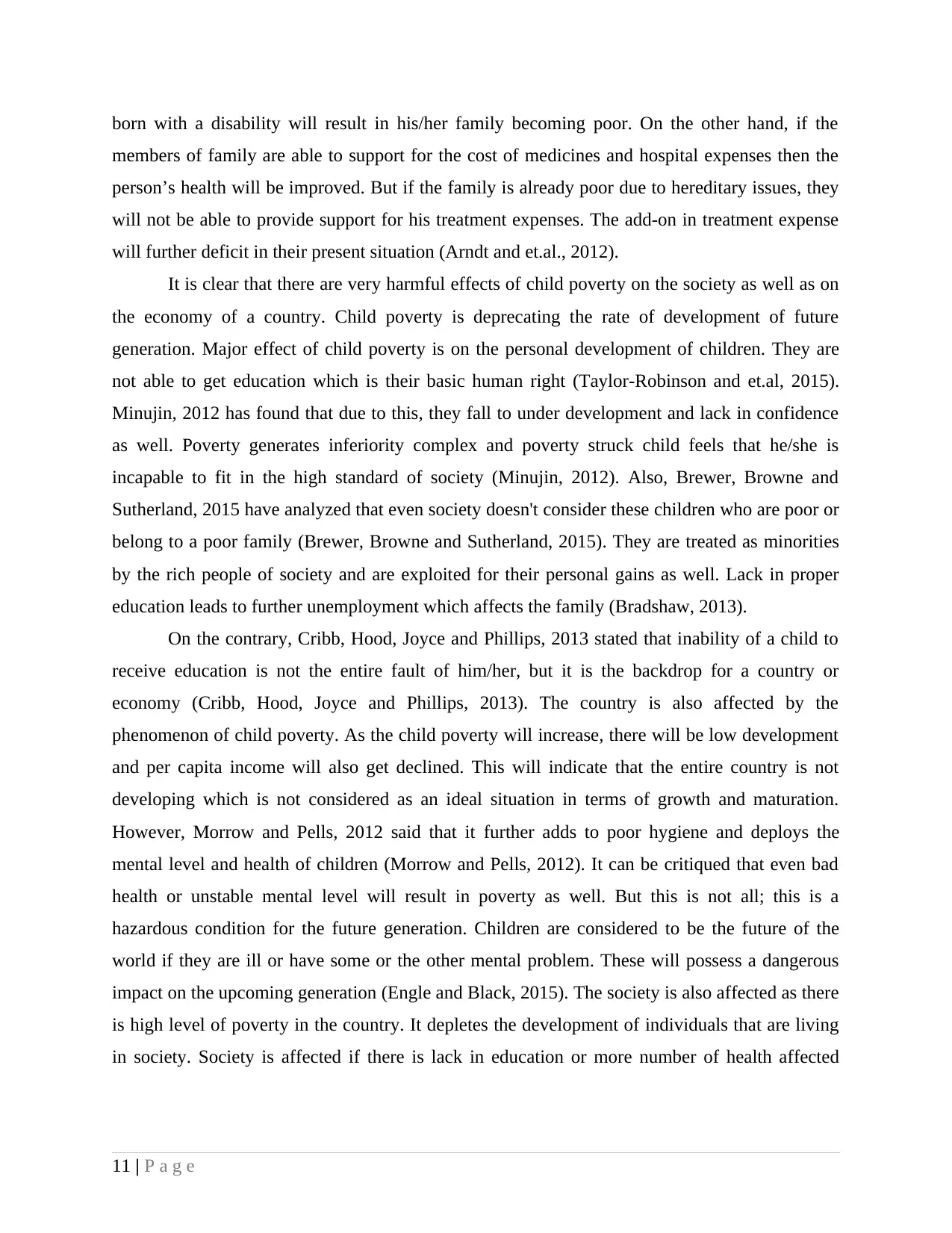
born with a disability will result in his/her family becoming poor. On the other hand, if the
members of family are able to support for the cost of medicines and hospital expenses then the
person’s health will be improved. But if the family is already poor due to hereditary issues, they
will not be able to provide support for his treatment expenses. The add-on in treatment expense
will further deficit in their present situation (Arndt and et.al., 2012).
It is clear that there are very harmful effects of child poverty on the society as well as on
the economy of a country. Child poverty is deprecating the rate of development of future
generation. Major effect of child poverty is on the personal development of children. They are
not able to get education which is their basic human right (Taylor-Robinson and et.al, 2015).
Minujin, 2012 has found that due to this, they fall to under development and lack in confidence
as well. Poverty generates inferiority complex and poverty struck child feels that he/she is
incapable to fit in the high standard of society (Minujin, 2012). Also, Brewer, Browne and
Sutherland, 2015 have analyzed that even society doesn't consider these children who are poor or
belong to a poor family (Brewer, Browne and Sutherland, 2015). They are treated as minorities
by the rich people of society and are exploited for their personal gains as well. Lack in proper
education leads to further unemployment which affects the family (Bradshaw, 2013).
On the contrary, Cribb, Hood, Joyce and Phillips, 2013 stated that inability of a child to
receive education is not the entire fault of him/her, but it is the backdrop for a country or
economy (Cribb, Hood, Joyce and Phillips, 2013). The country is also affected by the
phenomenon of child poverty. As the child poverty will increase, there will be low development
and per capita income will also get declined. This will indicate that the entire country is not
developing which is not considered as an ideal situation in terms of growth and maturation.
However, Morrow and Pells, 2012 said that it further adds to poor hygiene and deploys the
mental level and health of children (Morrow and Pells, 2012). It can be critiqued that even bad
health or unstable mental level will result in poverty as well. But this is not all; this is a
hazardous condition for the future generation. Children are considered to be the future of the
world if they are ill or have some or the other mental problem. These will possess a dangerous
impact on the upcoming generation (Engle and Black, 2015). The society is also affected as there
is high level of poverty in the country. It depletes the development of individuals that are living
in society. Society is affected if there is lack in education or more number of health affected
11 | P a g e
members of family are able to support for the cost of medicines and hospital expenses then the
person’s health will be improved. But if the family is already poor due to hereditary issues, they
will not be able to provide support for his treatment expenses. The add-on in treatment expense
will further deficit in their present situation (Arndt and et.al., 2012).
It is clear that there are very harmful effects of child poverty on the society as well as on
the economy of a country. Child poverty is deprecating the rate of development of future
generation. Major effect of child poverty is on the personal development of children. They are
not able to get education which is their basic human right (Taylor-Robinson and et.al, 2015).
Minujin, 2012 has found that due to this, they fall to under development and lack in confidence
as well. Poverty generates inferiority complex and poverty struck child feels that he/she is
incapable to fit in the high standard of society (Minujin, 2012). Also, Brewer, Browne and
Sutherland, 2015 have analyzed that even society doesn't consider these children who are poor or
belong to a poor family (Brewer, Browne and Sutherland, 2015). They are treated as minorities
by the rich people of society and are exploited for their personal gains as well. Lack in proper
education leads to further unemployment which affects the family (Bradshaw, 2013).
On the contrary, Cribb, Hood, Joyce and Phillips, 2013 stated that inability of a child to
receive education is not the entire fault of him/her, but it is the backdrop for a country or
economy (Cribb, Hood, Joyce and Phillips, 2013). The country is also affected by the
phenomenon of child poverty. As the child poverty will increase, there will be low development
and per capita income will also get declined. This will indicate that the entire country is not
developing which is not considered as an ideal situation in terms of growth and maturation.
However, Morrow and Pells, 2012 said that it further adds to poor hygiene and deploys the
mental level and health of children (Morrow and Pells, 2012). It can be critiqued that even bad
health or unstable mental level will result in poverty as well. But this is not all; this is a
hazardous condition for the future generation. Children are considered to be the future of the
world if they are ill or have some or the other mental problem. These will possess a dangerous
impact on the upcoming generation (Engle and Black, 2015). The society is also affected as there
is high level of poverty in the country. It depletes the development of individuals that are living
in society. Society is affected if there is lack in education or more number of health affected
11 | P a g e
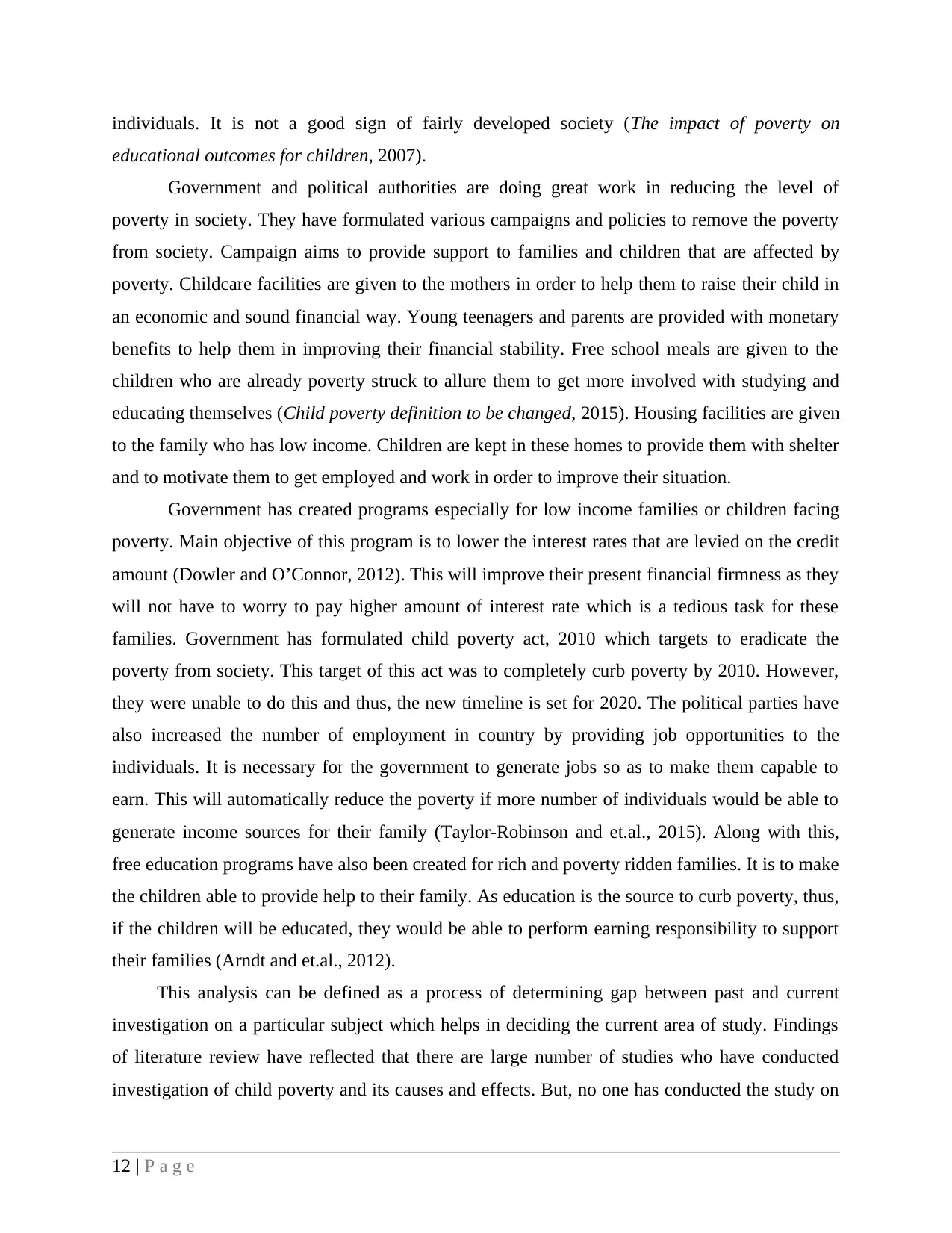
individuals. It is not a good sign of fairly developed society (The impact of poverty on
educational outcomes for children, 2007).
Government and political authorities are doing great work in reducing the level of
poverty in society. They have formulated various campaigns and policies to remove the poverty
from society. Campaign aims to provide support to families and children that are affected by
poverty. Childcare facilities are given to the mothers in order to help them to raise their child in
an economic and sound financial way. Young teenagers and parents are provided with monetary
benefits to help them in improving their financial stability. Free school meals are given to the
children who are already poverty struck to allure them to get more involved with studying and
educating themselves (Child poverty definition to be changed, 2015). Housing facilities are given
to the family who has low income. Children are kept in these homes to provide them with shelter
and to motivate them to get employed and work in order to improve their situation.
Government has created programs especially for low income families or children facing
poverty. Main objective of this program is to lower the interest rates that are levied on the credit
amount (Dowler and O’Connor, 2012). This will improve their present financial firmness as they
will not have to worry to pay higher amount of interest rate which is a tedious task for these
families. Government has formulated child poverty act, 2010 which targets to eradicate the
poverty from society. This target of this act was to completely curb poverty by 2010. However,
they were unable to do this and thus, the new timeline is set for 2020. The political parties have
also increased the number of employment in country by providing job opportunities to the
individuals. It is necessary for the government to generate jobs so as to make them capable to
earn. This will automatically reduce the poverty if more number of individuals would be able to
generate income sources for their family (Taylor-Robinson and et.al., 2015). Along with this,
free education programs have also been created for rich and poverty ridden families. It is to make
the children able to provide help to their family. As education is the source to curb poverty, thus,
if the children will be educated, they would be able to perform earning responsibility to support
their families (Arndt and et.al., 2012).
This analysis can be defined as a process of determining gap between past and current
investigation on a particular subject which helps in deciding the current area of study. Findings
of literature review have reflected that there are large number of studies who have conducted
investigation of child poverty and its causes and effects. But, no one has conducted the study on
12 | P a g e
educational outcomes for children, 2007).
Government and political authorities are doing great work in reducing the level of
poverty in society. They have formulated various campaigns and policies to remove the poverty
from society. Campaign aims to provide support to families and children that are affected by
poverty. Childcare facilities are given to the mothers in order to help them to raise their child in
an economic and sound financial way. Young teenagers and parents are provided with monetary
benefits to help them in improving their financial stability. Free school meals are given to the
children who are already poverty struck to allure them to get more involved with studying and
educating themselves (Child poverty definition to be changed, 2015). Housing facilities are given
to the family who has low income. Children are kept in these homes to provide them with shelter
and to motivate them to get employed and work in order to improve their situation.
Government has created programs especially for low income families or children facing
poverty. Main objective of this program is to lower the interest rates that are levied on the credit
amount (Dowler and O’Connor, 2012). This will improve their present financial firmness as they
will not have to worry to pay higher amount of interest rate which is a tedious task for these
families. Government has formulated child poverty act, 2010 which targets to eradicate the
poverty from society. This target of this act was to completely curb poverty by 2010. However,
they were unable to do this and thus, the new timeline is set for 2020. The political parties have
also increased the number of employment in country by providing job opportunities to the
individuals. It is necessary for the government to generate jobs so as to make them capable to
earn. This will automatically reduce the poverty if more number of individuals would be able to
generate income sources for their family (Taylor-Robinson and et.al., 2015). Along with this,
free education programs have also been created for rich and poverty ridden families. It is to make
the children able to provide help to their family. As education is the source to curb poverty, thus,
if the children will be educated, they would be able to perform earning responsibility to support
their families (Arndt and et.al., 2012).
This analysis can be defined as a process of determining gap between past and current
investigation on a particular subject which helps in deciding the current area of study. Findings
of literature review have reflected that there are large number of studies who have conducted
investigation of child poverty and its causes and effects. But, no one has conducted the study on
12 | P a g e
⊘ This is a preview!⊘
Do you want full access?
Subscribe today to unlock all pages.

Trusted by 1+ million students worldwide
1 out of 26
Related Documents
Your All-in-One AI-Powered Toolkit for Academic Success.
+13062052269
info@desklib.com
Available 24*7 on WhatsApp / Email
![[object Object]](/_next/static/media/star-bottom.7253800d.svg)
Unlock your academic potential
Copyright © 2020–2025 A2Z Services. All Rights Reserved. Developed and managed by ZUCOL.





